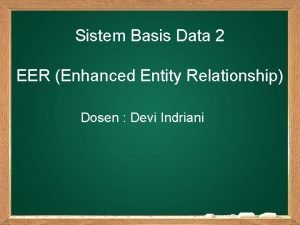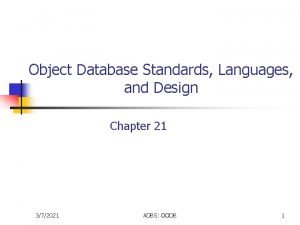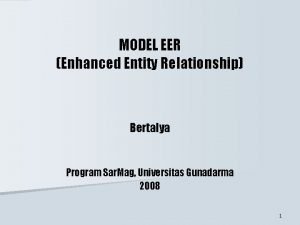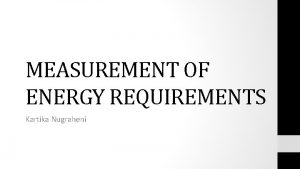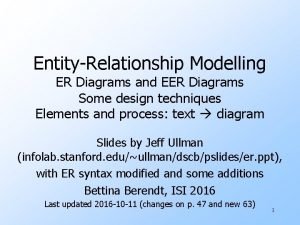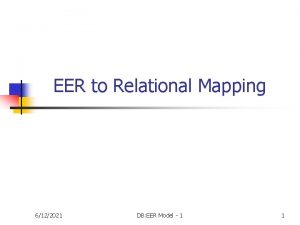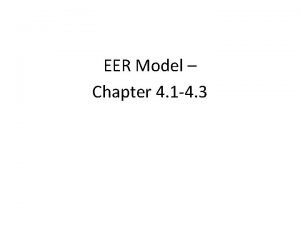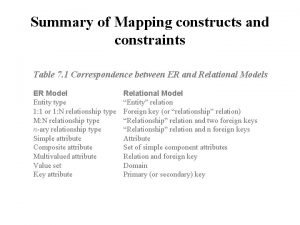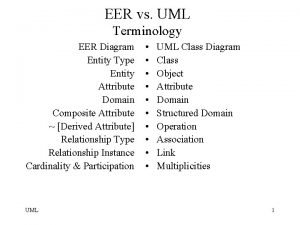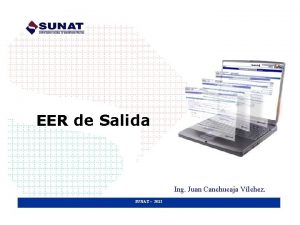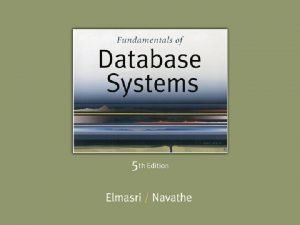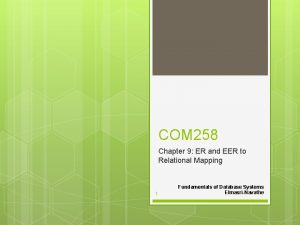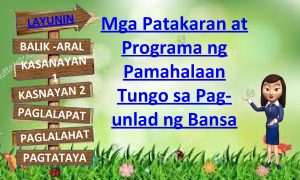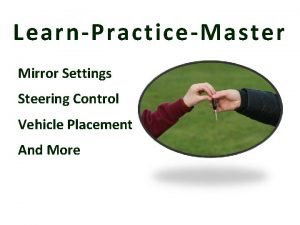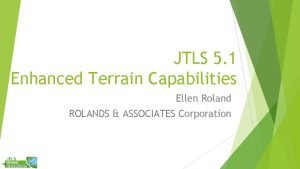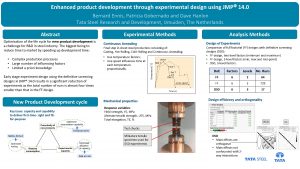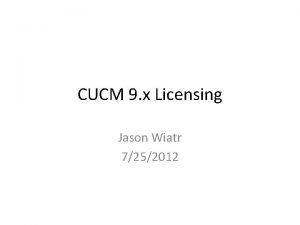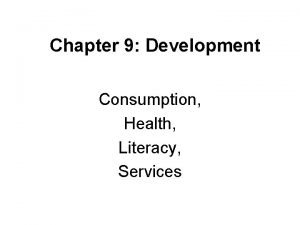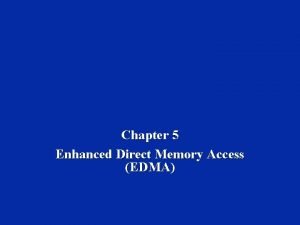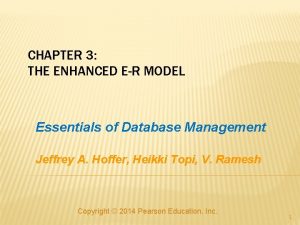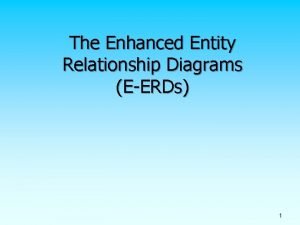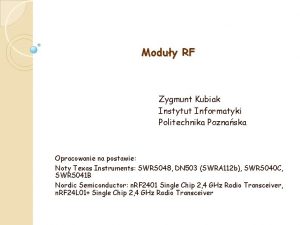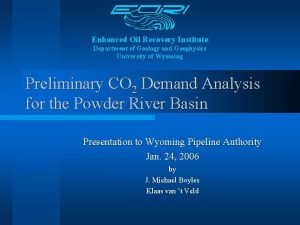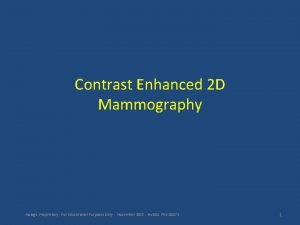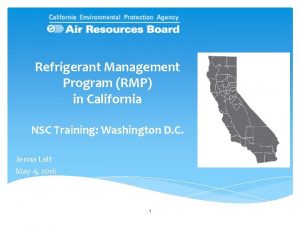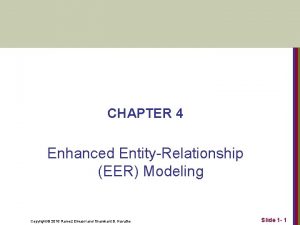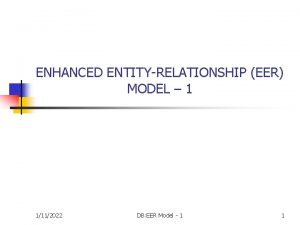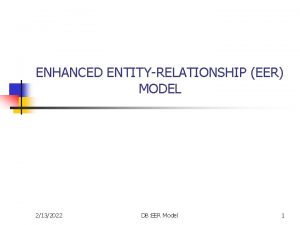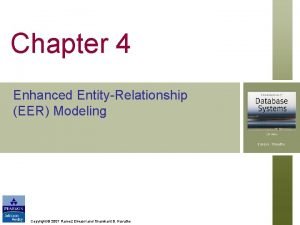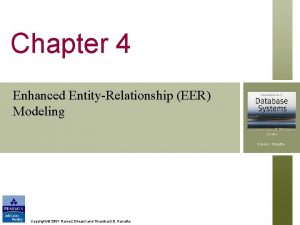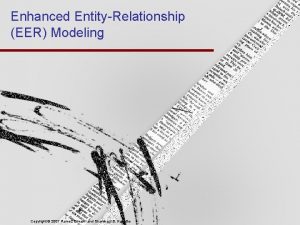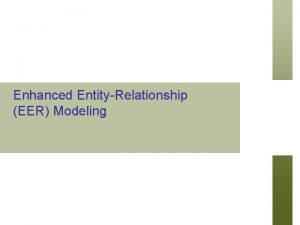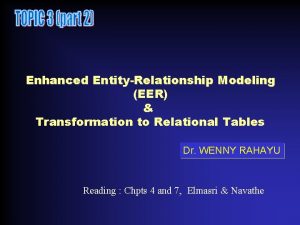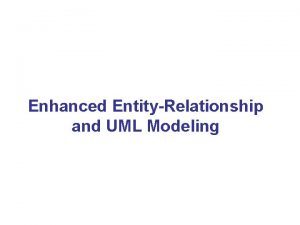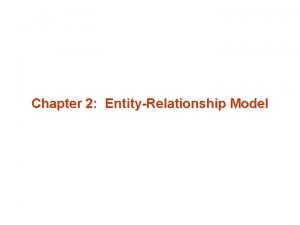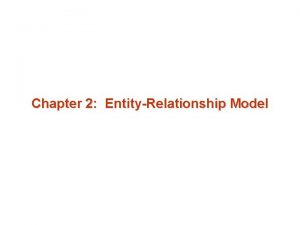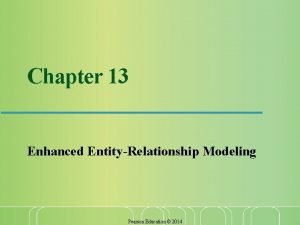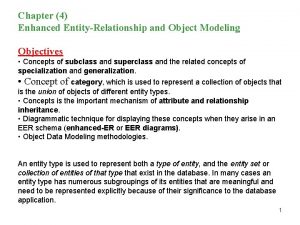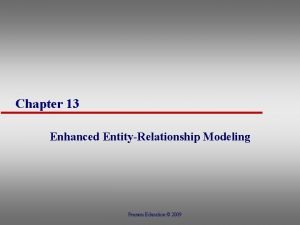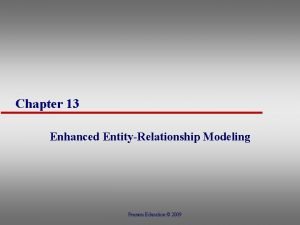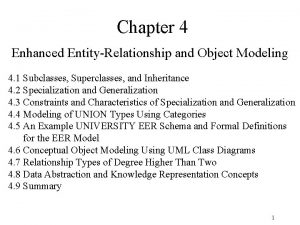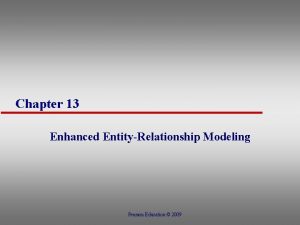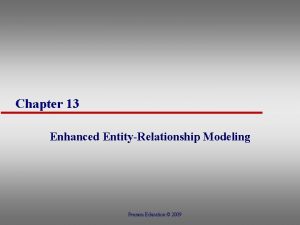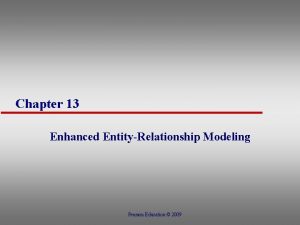CHAPTER 4 Enhanced EntityRelationship EER Modeling Copyright 2016















































- Slides: 47

CHAPTER 4 Enhanced Entity-Relationship (EER) Modeling Copyright © 2016 Ramez Elmasri and Shamkant B. Navathe Slide 1 - 1

Chapter Outline n n EER stands for Enhanced ER or Extended ER EER Model Concepts n n Includes all modeling concepts of basic ER Additional concepts: n n n Constraints on Specialization/Generalization The additional EER concepts are used to model applications more completely and more accurately n n subclasses/superclasses specialization/generalization categories (UNION types) attribute and relationship inheritance EER includes some object-oriented concepts, such as inheritance Knowledge Representation and Ontology Concepts Copyright © 2016 Ramez Elmasri and Shamkant B. Navathe Slide 4 - 2

Subclasses and Superclasses (1) n An entity type may have additional meaningful subgroupings of its entities n Example: EMPLOYEE may be further grouped into: n SECRETARY, ENGINEER, TECHNICIAN, … n n MANAGER n n EMPLOYEEs who are managers (the role they play) SALARIED_EMPLOYEE, HOURLY_EMPLOYEE n n Based on the EMPLOYEE’s Job Based on the EMPLOYEE’s method of pay EER diagrams extend ER diagrams to represent these additional subgroupings, called subclasses or subtypes Copyright © 2016 Ramez Elmasri and Shamkant B. Navathe Slide 4 - 3

Subclasses and Superclasses Copyright © 2016 Ramez Elmasri and Shamkant B. Navathe Slide 4 - 4

Subclasses and Superclasses (2) n n Each of these subgroupings is a subset of EMPLOYEE entities Each is called a subclass of EMPLOYEE is the superclass for each of these subclasses These are called superclass/subclass relationships: n n EMPLOYEE/SECRETARY EMPLOYEE/TECHNICIAN EMPLOYEE/MANAGER … Copyright © 2016 Ramez Elmasri and Shamkant B. Navathe Slide 4 - 5

Subclasses and Superclasses (3) n These are also called IS-A relationships n n SECRETARY IS-A EMPLOYEE, TECHNICIAN IS-A EMPLOYEE, …. Note: An entity that is member of a subclass represents the same real-world entity as some member of the superclass: n n n The subclass member is the same entity in a distinct specific role An entity cannot exist in the database merely by being a member of a subclass; it must also be a member of the superclass A member of the superclass can be optionally included as a member of any number of its subclasses Copyright © 2016 Ramez Elmasri and Shamkant B. Navathe Slide 4 - 6

Subclasses and Superclasses (4) n Examples: n A salaried employee who is also an engineer belongs to the two subclasses: n n n A salaried employee who is also an engineering manager belongs to the three subclasses: n n ENGINEER, and SALARIED_EMPLOYEE MANAGER, ENGINEER, and SALARIED_EMPLOYEE It is not necessary that every entity in a superclass be a member of some subclass Copyright © 2016 Ramez Elmasri and Shamkant B. Navathe Slide 4 - 7

Representing Specialization in EER Diagrams Copyright © 2016 Ramez Elmasri and Shamkant B. Navathe Slide 4 - 8

Attribute Inheritance in Superclass / Subclass Relationships n An entity that is member of a subclass inherits n n n All attributes of the entity as a member of the superclass All relationships of the entity as a member of the superclass Example: n n In the previous slide, SECRETARY (as well as TECHNICIAN and ENGINEER) inherit the attributes Name, SSN, …, from EMPLOYEE Every SECRETARY entity will have values for the inherited attributes Copyright © 2016 Ramez Elmasri and Shamkant B. Navathe Slide 4 - 9

Specialization (1) n n Specialization is the process of defining a set of subclasses of a superclass The set of subclasses is based upon some distinguishing characteristics of the entities in the superclass n n Example: {SECRETARY, ENGINEER, TECHNICIAN} is a specialization of EMPLOYEE based upon job type. Example: MANAGER is a specialization of EMPLOYEE based on the role the employee plays n May have several specializations of the same superclass Copyright © 2016 Ramez Elmasri and Shamkant B. Navathe Slide 4 - 10

Specialization (2) n Example: Another specialization of EMPLOYEE based on method of pay is {SALARIED_EMPLOYEE, HOURLY_EMPLOYEE}. n n Superclass/subclass relationships and specialization can be diagrammatically represented in EER diagrams Attributes of a subclass are called specific or local attributes. n n For example, the attribute Typing. Speed of SECRETARY The subclass can also participate in specific relationship types. n For example, a relationship BELONGS_TO of HOURLY_EMPLOYEE Copyright © 2016 Ramez Elmasri and Shamkant B. Navathe Slide 4 - 11

Specialization (3) Copyright © 2016 Ramez Elmasri and Shamkant B. Navathe Slide 4 - 12

Generalization n n Generalization is the reverse of the specialization process Several classes with common features are generalized into a superclass; n n original classes become its subclasses Example: CAR, TRUCK generalized into VEHICLE; n n n both CAR, TRUCK become subclasses of the superclass VEHICLE. We can view {CAR, TRUCK} as a specialization of VEHICLE Alternatively, we can view VEHICLE as a generalization of CAR and TRUCK Copyright © 2016 Ramez Elmasri and Shamkant B. Navathe Slide 4 - 13

Generalization (2) Copyright © 2016 Ramez Elmasri and Shamkant B. Navathe Slide 4 - 14

Generalization and Specialization (1) n Diagrammatic notations are sometimes used to distinguish between generalization and specialization n n Arrow pointing to the generalized superclass represents a generalization Arrows pointing to the specialized subclasses represent a specialization We do not use this notation because it is often subjective as to which process is more appropriate for a particular situation We advocate not drawing any arrows Copyright © 2016 Ramez Elmasri and Shamkant B. Navathe Slide 4 - 15

Generalization and Specialization (2) n Data Modeling with Specialization and Generalization n n A superclass or subclass represents a collection (or set or grouping) of entities It also represents a particular type of entity Shown in rectangles in EER diagrams (as are entity types) We can call entity types (and their corresponding collections) classes, whether they are entity types, superclasses, or subclasses Copyright © 2016 Ramez Elmasri and Shamkant B. Navathe Slide 4 - 16

Types of Specialization n Predicate-defined ( or condition-defined) : based on some predicate. E. g. , based on value of an attribute, say, Job-type, or Age. Attribute-defined: shows the name of the attribute next to the line drawn from the superclass toward the subclasses (see Fig. 4. 1) User-defined: membership is defined by the user on an entity by entity basis Copyright © 2016 Ramez Elmasri and Shamkant B. Navathe Slide 4 - 17

Constraints on Specialization and Generalization (1) n If we can determine exactly those entities that will become members of each subclass by a condition, the subclasses are called predicatedefined (or condition-defined) subclasses n n Condition is a constraint that determines subclass members Display a predicate-defined subclass by writing the predicate condition next to the line attaching the subclass to its superclass Copyright © 2016 Ramez Elmasri and Shamkant B. Navathe Slide 4 - 18

Constraints on Specialization and Generalization (2) n If all subclasses in a specialization have membership condition on same attribute of the superclass, specialization is called an attribute-defined specialization n Attribute is called the defining attribute of the specialization Example: Job. Type is the defining attribute of the specialization {SECRETARY, TECHNICIAN, ENGINEER} of EMPLOYEE If no condition determines membership, the subclass is called user-defined n n Membership in a subclass is determined by the database users by applying an operation to add an entity to the subclass Membership in the subclass is specified individually for each entity in the superclass by the user Copyright © 2016 Ramez Elmasri and Shamkant B. Navathe Slide 4 - 19

Displaying an attribute-defined specialization in EER diagrams Copyright © 2016 Ramez Elmasri and Shamkant B. Navathe Slide 4 - 20

Constraints on Specialization and Generalization (3) n Two basic constraints can apply to a specialization/generalization: n n Disjointness Constraint: Completeness Constraint: Copyright © 2016 Ramez Elmasri and Shamkant B. Navathe Slide 4 - 21

Constraints on Specialization and Generalization (4) n Disjointness Constraint: n Specifies that the subclasses of the specialization must be disjoint: n n n Specified by d in EER diagram If not disjoint, specialization is overlapping: n n an entity can be a member of at most one of the subclasses of the specialization that is the same entity may be a member of more than one subclass of the specialization Specified by o in EER diagram Copyright © 2016 Ramez Elmasri and Shamkant B. Navathe Slide 4 - 22

Constraints on Specialization and Generalization (5) n Completeness (Exhaustiveness) Constraint: n n Total specifies that every entity in the superclass must be a member of some subclass in the specialization/generalization Shown in EER diagrams by a double line Partial allows an entity not to belong to any of the subclasses Shown in EER diagrams by a single line Copyright © 2016 Ramez Elmasri and Shamkant B. Navathe Slide 4 - 23

Constraints on Specialization and Generalization (6) n Hence, we have four types of specialization/generalization: n n n Disjoint, total Disjoint, partial Overlapping, total Overlapping, partial Note: Generalization usually is total because the superclass is derived from the subclasses. Copyright © 2016 Ramez Elmasri and Shamkant B. Navathe Slide 4 - 24

Example of disjoint partial Specialization Copyright © 2016 Ramez Elmasri and Shamkant B. Navathe Slide 4 - 25

Example of overlapping total Specialization Copyright © 2016 Ramez Elmasri and Shamkant B. Navathe Slide 4 - 26

Specialization/Generalization Hierarchies, Lattices & Shared Subclasses (1) n A subclass may itself have further subclasses specified on it n n n forms a hierarchy or a lattice Hierarchy has a constraint that every subclass has only one superclass (called single inheritance); this is basically a tree structure In a lattice, a subclass can be subclass of more than one superclass (called multiple inheritance) Copyright © 2016 Ramez Elmasri and Shamkant B. Navathe Slide 4 - 27

Shared Subclass “Engineering_Manager” Copyright © 2016 Ramez Elmasri and Shamkant B. Navathe Slide 4 - 28

Specialization/Generalization Hierarchies, Lattices & Shared Subclasses (2) n n n In a lattice or hierarchy, a subclass inherits attributes not only of its direct superclass, but also of all its predecessor superclasses A subclass with more than one superclass is called a shared subclass (multiple inheritance) Can have: n n specialization hierarchies or lattices, or generalization hierarchies or lattices, depending on how they were derived We just use specialization (to stand for the end result of either specialization or generalization) Copyright © 2016 Ramez Elmasri and Shamkant B. Navathe Slide 4 - 29

Specialization/Generalization Hierarchies, Lattices & Shared Subclasses (3) n In specialization, start with an entity type and then define subclasses of the entity type by successive specialization n n In generalization, start with many entity types and generalize those that have common properties n n called a top down conceptual refinement process Called a bottom up conceptual synthesis process In practice, a combination of both processes is usually employed Copyright © 2016 Ramez Elmasri and Shamkant B. Navathe Slide 4 - 30

Specialization / Generalization Lattice Example (UNIVERSITY) Copyright © 2016 Ramez Elmasri and Shamkant B. Navathe Slide 4 - 31

Categories (UNION TYPES) (1) n n All of the superclass/subclass relationships we have seen thus far have a single superclass A shared subclass is a subclass in: n n n more than one distinct superclass/subclass relationships each relationships has a single superclass shared subclass leads to multiple inheritance In some cases, we need to model a single superclass/subclass relationship with more than one superclass Superclasses can represent different entity types Such a subclass is called a category or UNION TYPE Copyright © 2016 Ramez Elmasri and Shamkant B. Navathe Slide 4 - 32

Categories (UNION TYPES) (2) n Example: In a database for vehicle registration, a vehicle owner can be a PERSON, a BANK (holding a lien on a vehicle) or a COMPANY. n n n A category (UNION type) called OWNER is created to represent a subset of the union of the three superclasses COMPANY, BANK, and PERSON A category member must exist in at least one (typically just one) of its superclasses Difference from shared subclass, which is a: n n subset of the intersection of its superclasses shared subclass member must exist in all of its superclasses Copyright © 2016 Ramez Elmasri and Shamkant B. Navathe Slide 4 - 33

Two categories (UNION types): OWNER, REGISTERED_VEHICLE Copyright © 2016 Ramez Elmasri and Shamkant B. Navathe Slide 4 - 34

Formal Definitions of EER Model (1) n Class C: n A type of entity with a corresponding set of entities: n n n could be entity type, subclass, superclass, or category Note: The definition of relationship type in ER/EER should have 'entity type' replaced with 'class‘ to allow relationships among classes in general Subclass S is a class whose: n n Type inherits all the attributes and relationship of a class C Set of entities must always be a subset of the set of entities of the other class C n n n S⊆C C is called the superclass of S A superclass/subclass relationship exists between S and C Copyright © 2016 Ramez Elmasri and Shamkant B. Navathe Slide 4 - 35

Formal Definitions of EER Model (2) n Specialization Z: Z = {S 1, S 2, …, Sn} is a set of subclasses with same superclass G; hence, G/Si is a superclass relationship for i = 1, …. , n. n n G is called a generalization of the subclasses {S 1, S 2, …, Sn} Z is total if we always have: n n n Z is disjoint if we always have: n n S 1 ∪ S 2 ∪ … ∪ Sn = G; Otherwise, Z is partial. Si ∩ S 2 empty-set for i ≠ j; Otherwise, Z is overlapping. Copyright © 2016 Ramez Elmasri and Shamkant B. Navathe Slide 4 - 36

Formal Definitions of EER Model (3) n Subclass S of C is predicate defined if predicate (condition) p on attributes of C is used to specify membership in S; n n n that is, S = C[p], where C[p] is the set of entities in C that satisfy condition p A subclass not defined by a predicate is called userdefined Attribute-defined specialization: if a predicate A = ci (where A is an attribute of G and ci is a constant value from the domain of A) is used to specify membership in each subclass Si in Z n Note: If ci ≠ cj for i ≠ j, and A is single-valued, then the attribute-defined specialization will be disjoint. Copyright © 2016 Ramez Elmasri and Shamkant B. Navathe Slide 4 - 37

Formal Definitions of EER Model (4) n Category or UNION type T n A class that is a subset of the union of n defining superclasses D 1, D 2, …Dn, n>1: n n n T ⊆ (D 1 ∪ D 2 ∪ … ∪ Dn) Can have a predicate pi on the attributes of Di to specify entities of Di that are members of T. If a predicate is specified on every Di: T = (D 1[p 1] ∪ D 2[p 2] ∪…∪ Dn[pn]) Copyright © 2016 Ramez Elmasri and Shamkant B. Navathe Slide 4 - 38

Alternative diagrammatic notations n n ER/EER diagrams are a specific notation for displaying the concepts of the model diagrammatically DB design tools use many alternative notations for the same or similar concepts One popular alternative notation uses UML class diagrams see next slides for UML class diagrams and other alternative notations Copyright © 2016 Ramez Elmasri and Shamkant B. Navathe Slide 4 - 39

UML Example for Displaying Specialization / Generalization Copyright © 2016 Ramez Elmasri and Shamkant B. Navathe Slide 4 - 40

Alternative Diagrammatic Notations Copyright © 2016 Ramez Elmasri and Shamkant B. Navathe Slide 4 - 41

Knowledge Representation (KR)-1 n n Deals with modeling and representing a certain domain of knowledge. Typically done by using some formal model of representation and by creating an Ontology An ontology for a specific domain of interest describes a set of concepts and interrelationships among those concepts An Ontology serves as a “schema” which enables interpretation of the knowledge in a “knowledgebase” Copyright © 2016 Ramez Elmasri and Shamkant B. Navathe Slide 4 - 42

Knowledge Representation (KR)-2 COMMON FEATURES between KR and Data Models: n Both use similar set of abstractions – classification, aggregation, generalization, and identification. n Both provide concepts, relationships, constraints, operations and languages to represent knowledge and model data DIFFERENCES: n KR has broader scope: tries to deal with missing and incomplete knowledge, default and common-sense knowledge etc. Copyright © 2016 Ramez Elmasri and Shamkant B. Navathe Slide 4 - 43

Knowledge Representation (KR)-3 DIFFERENCES (continued): n KR schemes typically include rules and reasoning mechanisms for inferencing n Most KR techniques involve data and metadata. In data modeling, these are treated separately n KR is used in conjunction with artificial intelligence systems to do decision support applications For more details on spatial, temporal and multimedia data modeling, see Chapter 26. For details on use of Ontologies see Sections 27. 4. 3 and 27. 7. 4. Copyright © 2016 Ramez Elmasri and Shamkant B. Navathe Slide 4 - 44

General Basis for Conceptual Modeling n TYPES OF DATA ABSTRACTIONS n n n CLASSIFICATION and INSTANTIATION AGGREGATION and ASSOCIATION (relationships) GENERALIZATION and SPECIALIZATION IDENTIFICATION CONSTRAINTS n n CARDINALITY (Min and Max) COVERAGE (Total vs. Partial, and Exclusive (Disjoint) vs. Overlapping) Copyright © 2016 Ramez Elmasri and Shamkant B. Navathe Slide 4 - 45

Ontologies n Use conceptual modeling and other tools to develop “a specification of a conceptualization” n n n Specification refers to the language and vocabulary (data model concepts) used Conceptualization refers to the description (schema) of the concepts of a particular field of knowledge and the relationships among these concepts Many medical, scientific, and engineering ontologies are being developed as a means of standardizing concepts and terminology Copyright © 2016 Ramez Elmasri and Shamkant B. Navathe Slide 4 - 46

Summary n n n Introduced the EER model concepts n Class/subclass relationships n Specialization and generalization n Inheritance Constraints on EER schemas These augment the basic ER model concepts introduced in Chapter 3 EER diagrams and alternative notations were presented Knowledge Representation and Ontologies were introduced and compared with Data Modeling Copyright © 2016 Ramez Elmasri and Shamkant B. Navathe Slide 4 - 47
 Enhanced entity relationship
Enhanced entity relationship Model and role modeling theory
Model and role modeling theory Dimensional modeling vs relational modeling
Dimensional modeling vs relational modeling Microsoft azure threat modeling tool
Microsoft azure threat modeling tool Seer vs ieer
Seer vs ieer Eer diagram
Eer diagram Mapping eer to odb schema
Mapping eer to odb schema Eer formula
Eer formula Eer
Eer Perbedaan rumus harris benedict dan mifflin
Perbedaan rumus harris benedict dan mifflin Eer vs er
Eer vs er Enhanced entity-relationship model
Enhanced entity-relationship model Eer diagram
Eer diagram Rumus eer anak
Rumus eer anak Eer model
Eer model Eer
Eer Uml terminology
Uml terminology Manifiesto eer
Manifiesto eer Manifiesto eer
Manifiesto eer Eer modell
Eer modell Er and eer
Er and eer Cisco 3750x warranty
Cisco 3750x warranty Draw the general format for pgp message
Draw the general format for pgp message Nptel
Nptel Mga programa sa edukasyon
Mga programa sa edukasyon What is enhanced mirror settings
What is enhanced mirror settings Enhanced terrain layer
Enhanced terrain layer Enhanced product development
Enhanced product development Enhanced interior gateway routing protocol
Enhanced interior gateway routing protocol Cucm enhanced license
Cucm enhanced license What is cpesn
What is cpesn What does alice training mean
What does alice training mean Buried in barstow enhanced edition
Buried in barstow enhanced edition Enhanced dicom
Enhanced dicom Enhanced greenhouse effect
Enhanced greenhouse effect Enhanced direct memory access
Enhanced direct memory access Partial specialization rule
Partial specialization rule Disjointness constraint
Disjointness constraint Poznaska
Poznaska Enhanced primary care mental health
Enhanced primary care mental health Enhanced oil recovery institute
Enhanced oil recovery institute Disturbed personal identity
Disturbed personal identity Enhanced security administrative environment
Enhanced security administrative environment Hologic contrast enhanced mammography
Hologic contrast enhanced mammography Enhanced disability management program
Enhanced disability management program Refrigerant management program
Refrigerant management program Enhanced health in care homes
Enhanced health in care homes E-marketing enhanced product development
E-marketing enhanced product development





